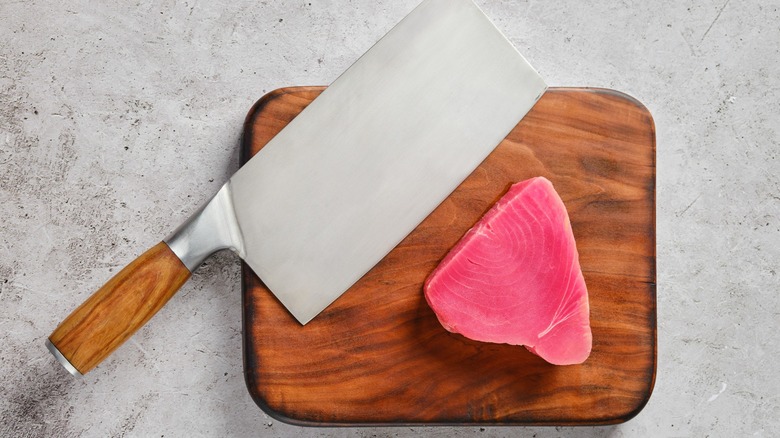How To Keep The Fish In Your Homemade Poke Bowl Tasting As Fresh As Possible
We may receive a commission on purchases made from links.
Most poke bowls are made with ahi tuna, which is best when sourced from a reputable fish monger, who will ensure that the ahi you buy is sushi grade, meaning it was just cut from a fresh-caught fish or, as some sushi restaurants often do — even in Japan — frozen and defrosted. If you're making a poke bowl, or any type of sushi, it's imperative that you keep the raw fish wrapped and chilled in the refrigerator until you're ready to prepare the poke. Properly dicing the fish takes time, and so you want to keep the fish as fresh-tasting as possible as you assemble the remaining ingredients. A sharp kitchen knife is essential but equally as important is an impeccably clean, nonporous cutting board.
Whenever you're working with raw seafood, meat, or poultry, cross-contamination is always a concern, as bacteria — particularly campylobacter, a virulent bacteria responsible for an estimated 1.5 million case of U.S. foodborne illnesses per year — flourishes on poorly cleaned cutting boards. You may have a favorite cutting board for carving, which after a quick wipe-down, you also use for prepping raw chicken or meat. This is a major no-no, according to chefs and other culinary experts. Certain types of cutting boards retain flavors and odors, which can then be absorbed by your fresh fish, but the fish can also pass on its own taste and smell to meat. Rather than use a multi-purpose cutting board, it's recommended to have at least a second one at hand.
Not all cutting boards are great for making poke
You can find cutting boards made of many different types of material. Marble cutting boards are brutal to knives and are best used for serving bread or cheese. A wood cutting board is kinder to knives, but it should be manufactured from a single piece of wood and not cobbled-together wood planks, as bacteria can sneak its way between cracks. With repeated use, wood cutting boards will get grooved by knives, causing areas that provide another breeding ground for bacteria; the USDA recommends tossing them out when they are worn. Bamboo cutting boards, however, aren't as porous as wood (bamboo is technically a grass). So they hold up well to frequent knife cuts, and because bamboo grows incredibly fast, a cutting board like this large bamboo pre-oiled Hiware version is more eco-friendly than most as well.
Other choices are cutting boards made of acrylic, plastic, or rubber (which restaurants tend to use). These benefit from being heat-resistant and washable in the dishwasher, so they're easy to maintain, although they also wear out over time. Plastic cutting boards tend to be affordable (this set of three on Amazon is just over $10), and are often available in different colors that can be coded for cutting fish, poultry, meat, and bread.
Whichever material you choose, any cutting board must be cleaned and sanitized after every use. Wood and bamboo cutting boards should never go in the dishwasher and should be gently cleaned with dish soap and a non-abrasive sponge or cloth. It's also a good idea to season a wood cutting board as an additional protective shield against bacteria and repellent against odors and tastes that can ruin your poke's fresh flavors.

